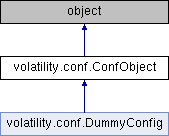This is a singleton class to manage the configuration. More...

Public Member Functions | |
| def | __init__ (self) |
| This is a singleton object kept in the class. | |
| def | set_usage |
| def | add_file |
| Adds a new file to parse. | |
| def | print_help (self) |
| def | add_help_hook (self, cb) |
| Adds an epilog to the help message. | |
| def | set_help_hook (self, cb) |
| def | parse_options |
| Parses the options from command line and any conf files currently added. More... | |
| def | remove_option (self, option) |
| Removes options both from the config file parser and the command line parser. More... | |
| def | add_option (self, option, short_option=None, cache_invalidator=True, args) |
| Adds options both to the config file parser and the command line parser. More... | |
| def | update (self, key, value) |
| This can be used by scripts to force a value of an option. | |
| def | get_value (self, key) |
| def | __getattr__ (self, attr) |
Public Attributes | |
| opts | |
| If someone is looking for a configuration parameter but we have not parsed anything yet - do so now. More... | |
Static Public Attributes | |
| tuple | optparser |
| initialised = False | |
| tuple | g_dict = dict(__builtins__ = None) |
| This is the globals dictionary which will be used for evaluating the configuration directives. More... | |
| dictionary | cnf_opts = {} |
| These are the options derived by reading any config files. | |
| dictionary | opts = {} |
| Command line opts. | |
| args = None | |
| dictionary | default_opts = {} |
| dictionary | docstrings = {} |
| optparse_opts = None | |
| These are the actual options returned by the optparser: More... | |
| dictionary | readonly = {} |
| These parameters can not be updated by the GUI (but will be propagated into new configuration files) | |
| list | options = [] |
| A list of option names: | |
| dictionary | cache_invalidators = {} |
| Cache variants: There are configuration options which encapsulate the state of the running program. More... | |
This is a singleton class to manage the configuration.
This means it can be instantiated many times, but each instance refers to the global configuration (which is set in class variables).
NOTE: The class attributes have static dicts assigned to facilitate singleton behaviour. This means all future instances will have the same dicts.
| def volatility.conf.ConfObject.add_option | ( | self, | |
| option, | |||
short_option = None, |
|||
cache_invalidator = True, |
|||
| args | |||
| ) |
Adds options both to the config file parser and the command line parser.
Args: option: The long option name. short_option: An optional short option. cache_invalidator: If set, when this option changes all caches are invalidated.
| def volatility.conf.ConfObject.parse_options | ( | self, | |
final = True |
|||
| ) |
Parses the options from command line and any conf files currently added.
The final parameter should be only called from main programs at the point where they are prepared for us to call exit if required; (For example when we detect the -h parameter).
| def volatility.conf.ConfObject.remove_option | ( | self, | |
| option | |||
| ) |
Removes options both from the config file parser and the command line parser.
This should only by used on options before they have been read, otherwise things could get very confusing.
|
static |
Cache variants: There are configuration options which encapsulate the state of the running program.
If any of these change all caches will be invalidated.
|
static |
This is the globals dictionary which will be used for evaluating the configuration directives.
|
static |
These are the actual options returned by the optparser:
Parse the command line options:
Update our cmdline dict: If error() was called we catch it here This gives us as much as was parsed so far
|
static |
| volatility.conf.ConfObject.opts |
If someone is looking for a configuration parameter but we have not parsed anything yet - do so now.